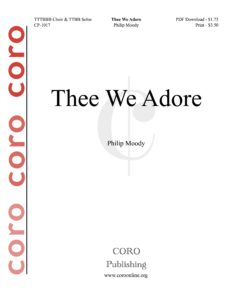Thee We Adore
Philip Moody Multiple Voicings Duration: 5 minutes Difficulty: 5
PDF Download: $1.75 Print: $3.50
TTTBBB/TTBB Solos
SSSAAA/TTBB
SSAATB/AATB
Recorded by Cantus on “Introit”
Thee We Adore is a piece that was inspired by Franz Biebl’s cherished setting of “Ave Maria.” I was still with Cantus, the full-time professional male vocal ensemble in Minneapolis, when the Biebl become a staple of our repertoire. For our first major tour of the east coast in the summer 1998, I wanted to write a piece that had some of the same ideas of flowing lines, chant-based melodies, and the antiphonal texture, but with a new twist. Thee We Adore was originally composed for 10 male vocal parts: a 6-part chorus and a solo quartet, but after having many conductors ask me if there was a mixed choir arrangement, I decided to create one. The piece combines the gregorian chant tune, originally presented in an organum setting with the full men’s chorus, and alleluias from the solo male quartet that have a more 21st- century style. Although the piece is strophic and verse one and four are set identically, I was also drawn to the individual verses. The mood of the second verse seemed to bring me back to an earlier time and a simple unison delivery of the gregorian chant seemed to be the perfect choice. With the third verse, an image of an old outdoor fountain found within the gardens of an estate continued to come to mind. The bubbling water at the top that would flow down into many levels of shallow pools and then be sent back to the top to continue the journey reminds me of the goodness of God: his forgiving nature, his understanding and compassion that always flows forth. These ideas inspired the vocal fountain for the third verse found in the solo quartet.
I will also add that in creating the mixed version, I first decided to move the chant organum to a 6-part chorus of sopranos and altos, with a full male chorus taking the original solo quartet lines. I felt that this was the truest way to present the piece, knowing that the majority of mixed choirs tend to have larger soprano and alto sections than tenor and bass sections; however, the upper soprano parts do sit very high in their range and I would recommend only one or two sopranos float the top part, or possibly the top two soprano parts. The alternate mixed version still needs the same voice parts, but in creating a mixed ensemble in both choirs, the ranges are more accessible.
– Philip Moody
Text
Who in Thy sacrament art pleased to be;
Both flesh and spirit in Thy presence fail,
Yet here Thy presence we devoutly hail.
O blest memorial of our dying Lord.
Who living Bread to men doth here afford;
Oh, may our souls forever feed on Thee,
and Thou, O Christ, forever precious be.
Cleanse us, unclean, with Thy most cleansing blood;
Increase our faith and love, that we may know
the hope and peace which from Thy presence flow.
O Christ, whom now beneath a veil we see,
May what we thirst for soon our portion be,
To gaze on Thee unveiled, and see Thy face,
The vision of Thy glory and Thy grace. Amen.
-Thomas Aquinas (1226-1274) originally in Latin
-English Translation by James R. Woodford


